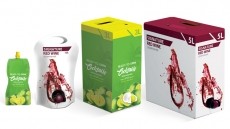Lightweight foamed PET process boosts performance of bottles and jars
US company Plastic Technologies Inc (PTI) said because the new foam process for bottle or jars adds stiffness, lightweighting of up to five percent was also feasible without significant loss of performance. Furthermore, the technology can produce bottles with significant light barrier characteristics, resulting in up to 95 percent reduction in transmitted light, said the firm.
The company explained the process was being marketed under the oPTISM (pronounced Opti) brand name and was based on MuCell technology licensed from Trexel, Inc.
Detailing some of the improvements in container appearance it believes it brings, PTI said the process enables white or silvery coloured bottles to be made without additives which can limit package recycling. Containers have what the firm describes as a unique surface feel that provides traction and prevents slippage. Decorations, such as embossed logos, stand out better as a result of the blow mold process.
PTI vice president Frank Semersky said: “"White oPTI bottles provide an environmentally-friendly option to conventional bottles which use additives to achieve a similar tint. Instead of being a contaminant to the clear recycling stream, white foamed bottles will mold into a transparent bottle after re-melting and subsequent processing,"
Bottles of varying colours can be produced by the process, including those of blue and green hues as these colour streams already exist in traditional PET recycling. It can also produce a range of pastel colours, such as amber, yellow and pink, but these cannot be recycled as part of the clear PET stream. Containers can be made from slightly translucent to opaque depending on the desired aesthetics and performance characteristics, said PTI.
"Initial evidence is that at higher gas levels, foam containers can withstand hot filling without excessive shrinkage. This means that hot-fill applications are within the realm of possibility," Semersky said. "We also can run foam bottles with a variety of barrier additives to meet shelf life concerns."












